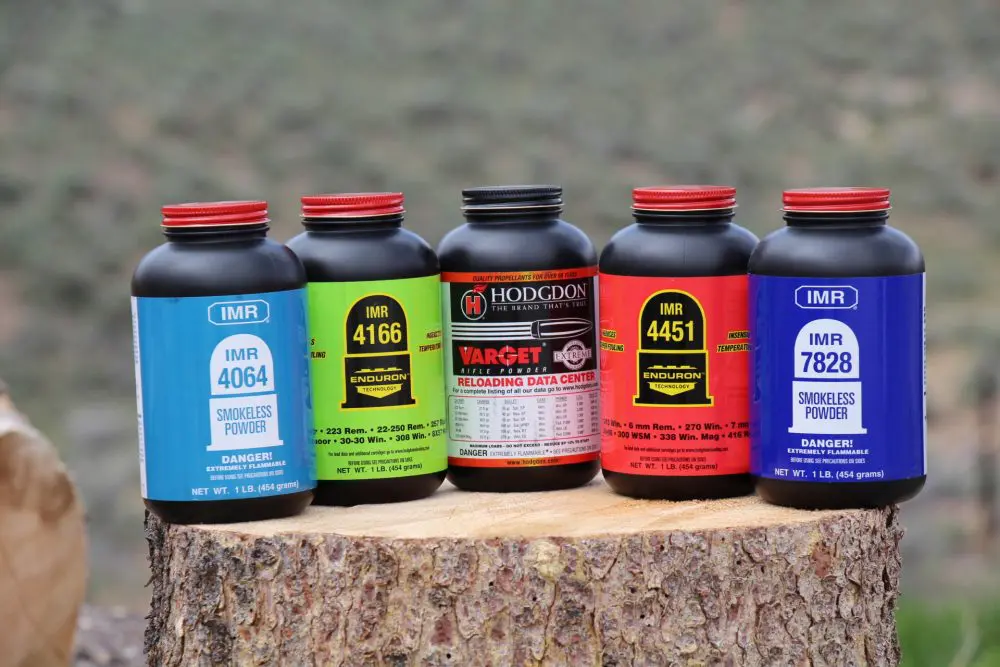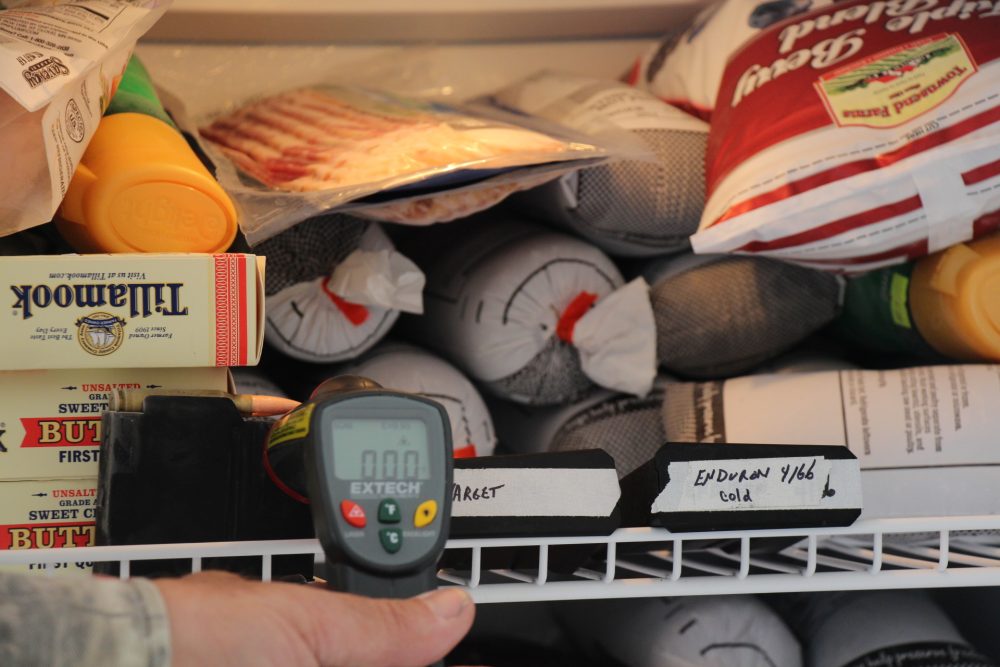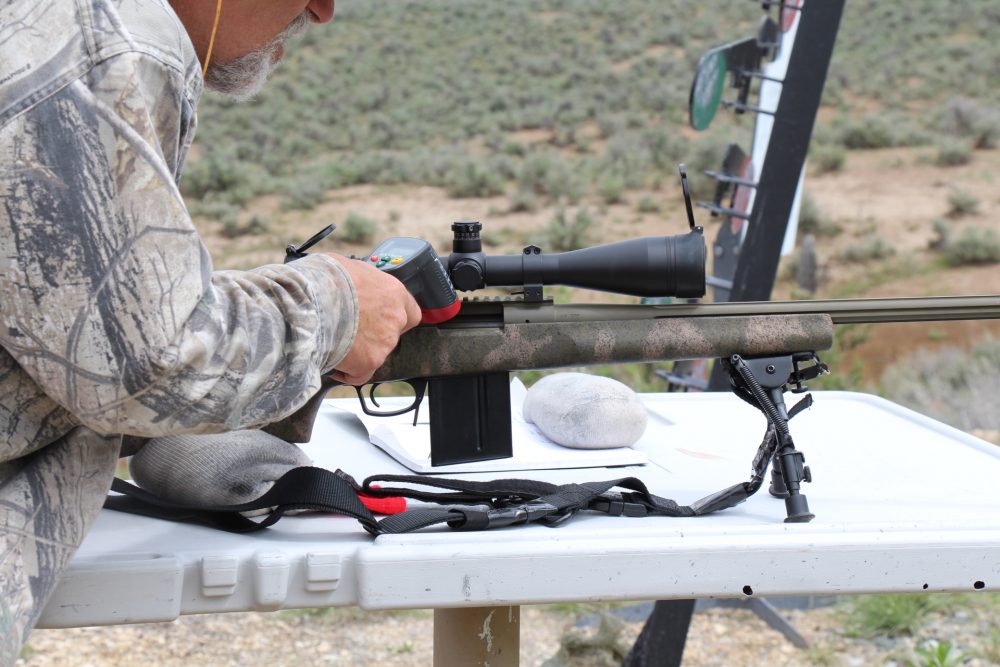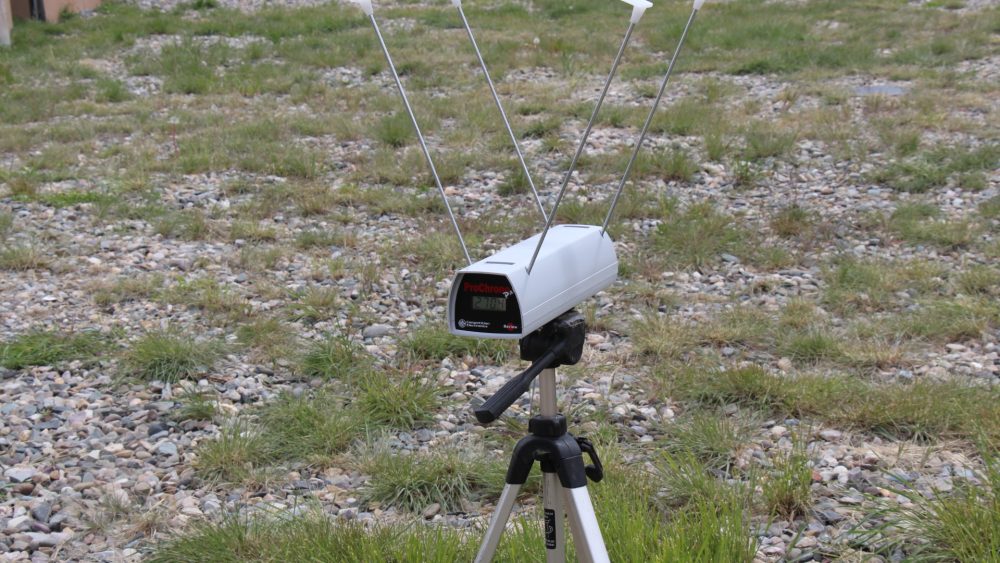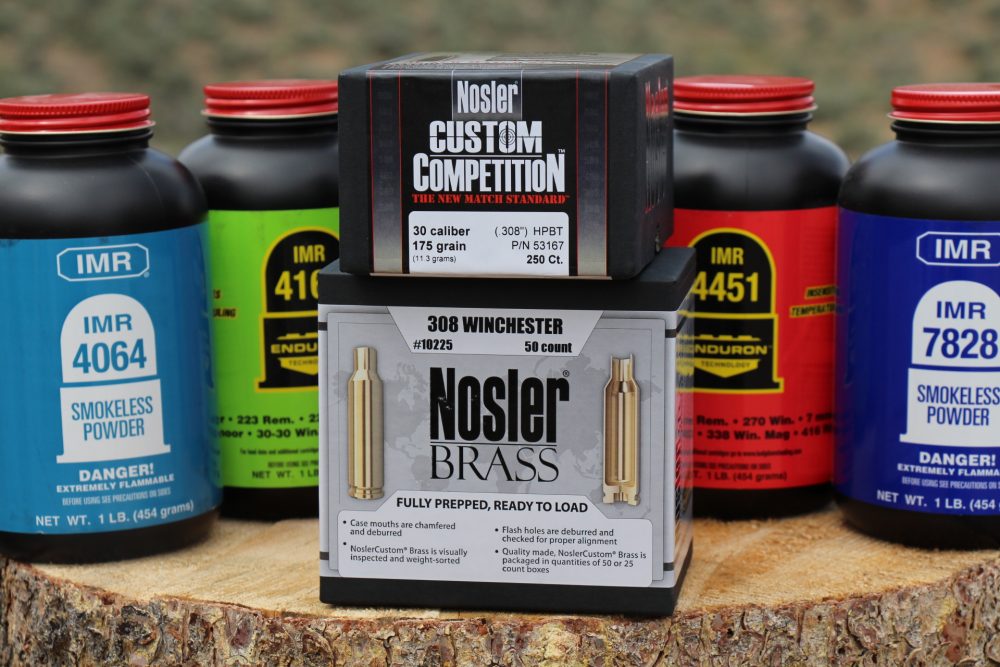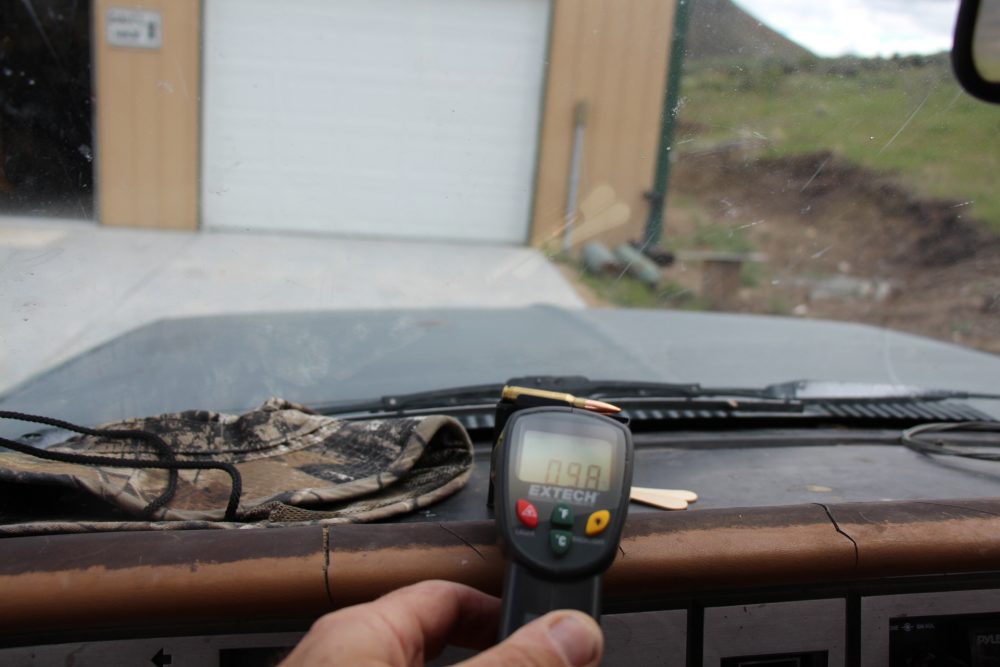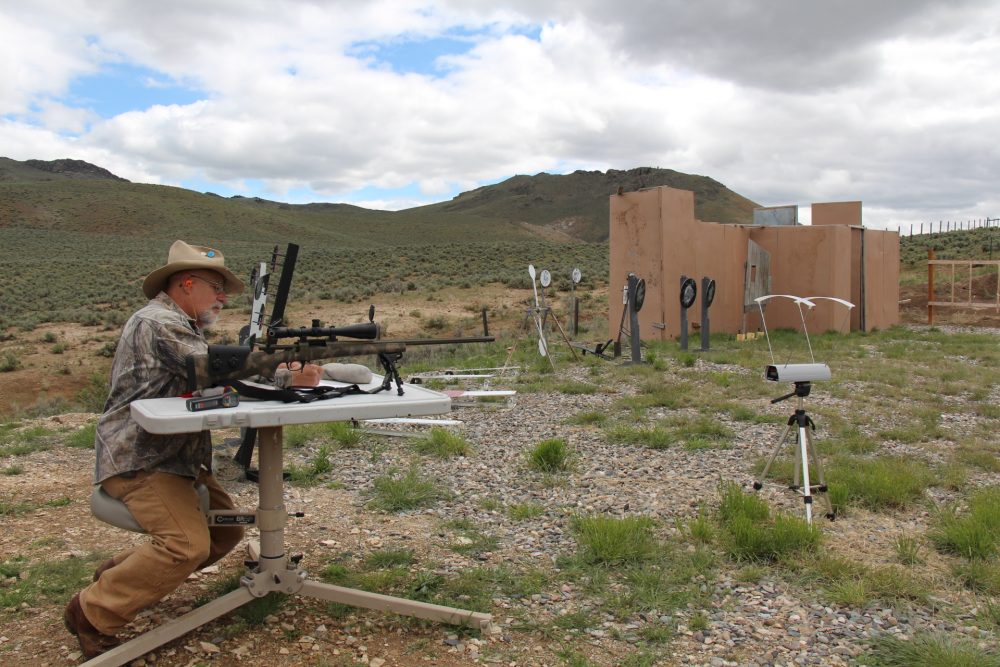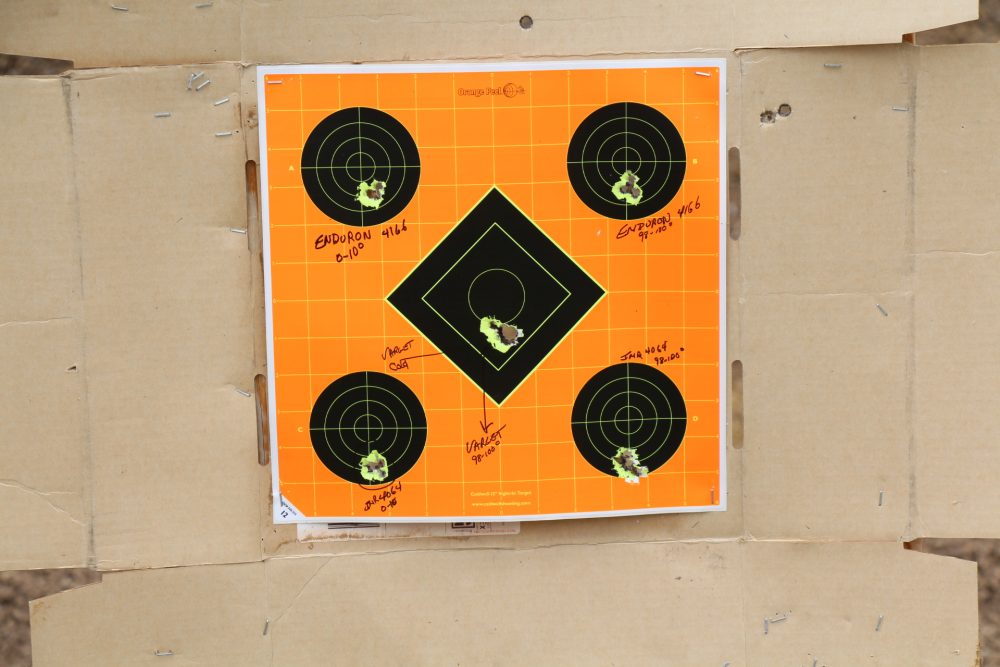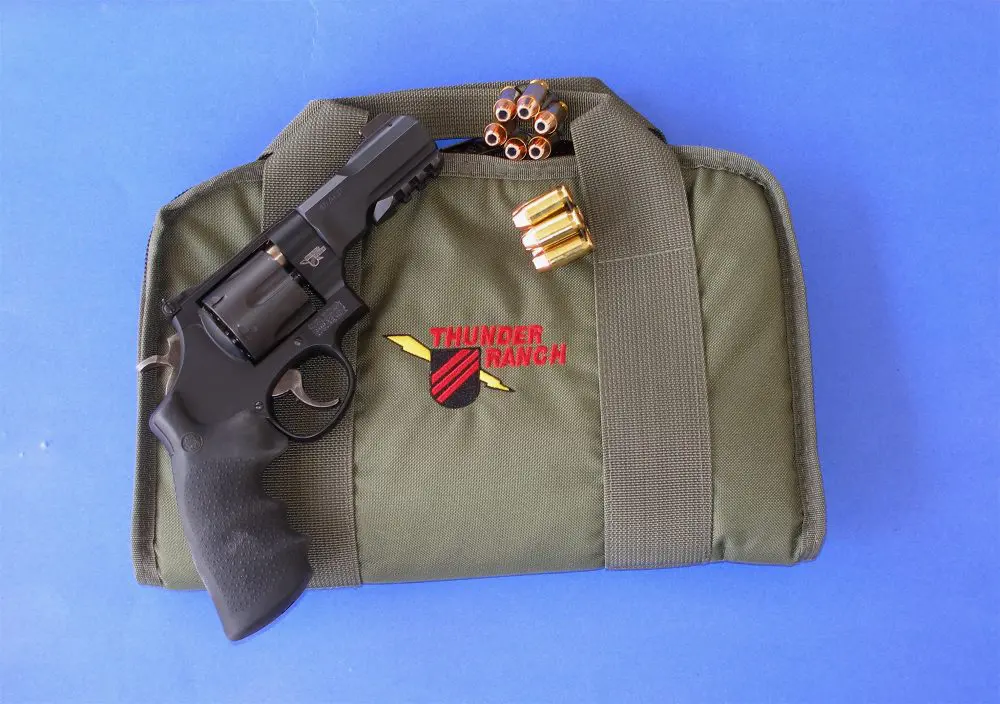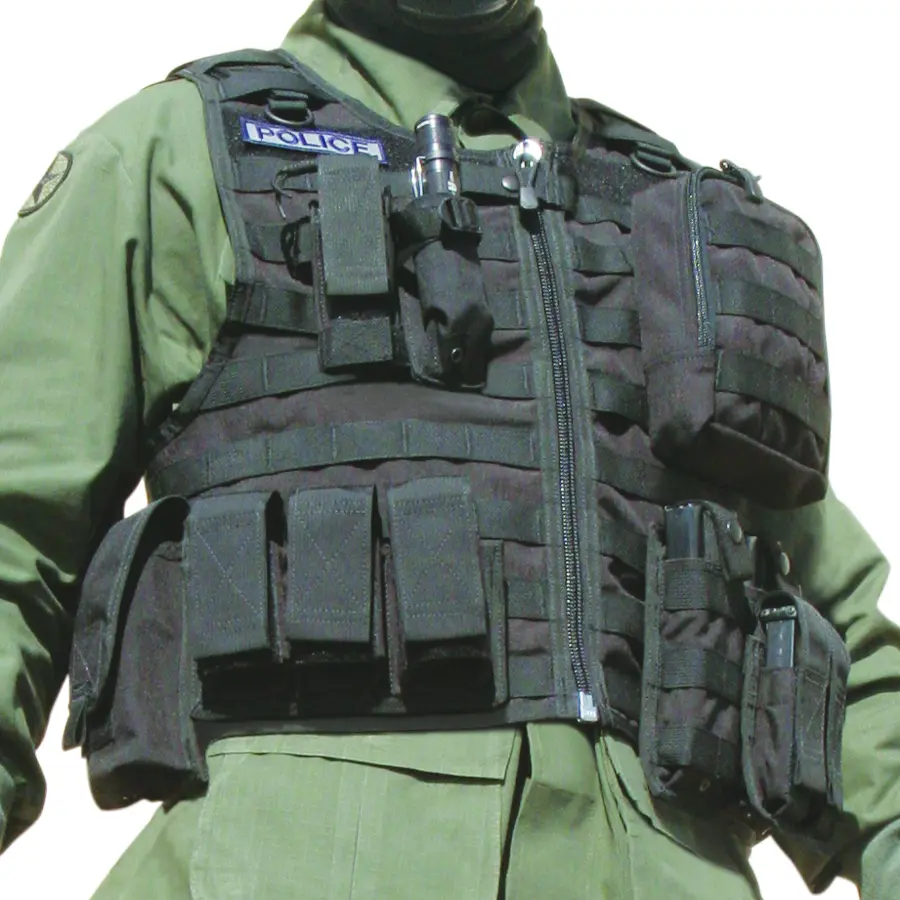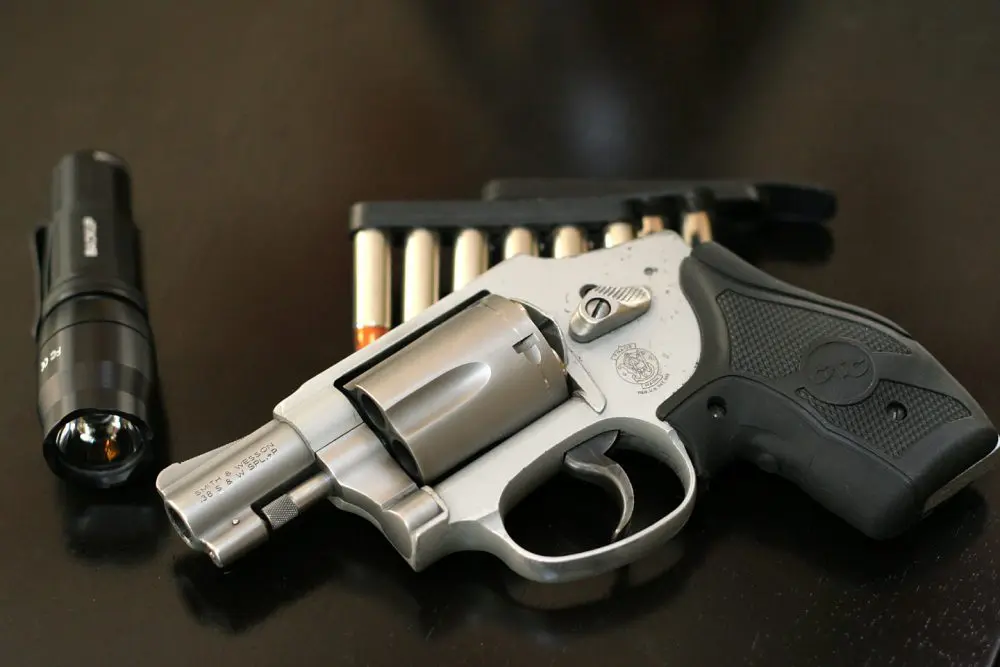Temperature of rounds rose just a few degrees from author’s freezer before shooting.
Recently I have heard long-range shooters talking about powder temperature affecting external ballistic performance of their favorite cartridge. We all know that the temperature of the air, along with other atmospheric conditions, causes the trajectory to change because of increased or decreased friction in the atmosphere, but what about the burning of the powder at different temperatures?
Varget was developed and boasted that it was unaffected by temperature, and now Hodgdon Powders has the Enduron Series of powders that are unaffected by temperature.
I have even heard some benchers talk about accounting for the temperature of the cartridge as it warms up in the chamber as it is fired. This is not something I worry about. Most of my shooting, whether hunting or professional, will most likely be done from a cold bore.
Table of Contents
TEMPERATURE OF RESTING POWDER
But I am curious if the temperature of the resting powder is anything to worry about in long-range shooting. As the temperature changes at different times of the year, I routinely check and adjust my zero, especially for hunting coyotes, because they are small targets at long range.
This is a zero at 100 yards, and the reason I do it is because the air temperature changes point of impact. So what about ammo that is zeroed in cold temperatures, but the ammo came out of a box in the truck, like what might happen when zeroing the rifle? After the ammo has been in the gun for a while on a coyote stand in zero-degree weather, will the colder powder burn differently?
I decided to test several powders to see if there is anything I needed to adjust for when the temperature of the powder changed.
Temperature of chambered round was recorded before each shot.
POWDERS TESTED
The first powder I tested was IMR 4064. I have been using this powder for my .308 Winchester loadings for 30 years. I have no reason to change to Varget, although many people I shoot with talk highly on it, so I decided to test Varget also with the 4064. I tested the Enduron 4166 also, because it is recommended for the .308 and many other calibers. The Enduron also has CFE (Copper Fouling Eliminator) added to reduce copper fouling.
I also load IMR 7828 in a .300 Winchester Magnum and planned on comparing it with the Enduron Powder recommended for the .300. I was interested to see if there would be a difference that needed to be figured in for long-range groups. I think the difference would be negligible at closer ranges. I’d measure the velocity at the muzzle of each load and record the changes in five-shot averages so the correction, if any, would most likely change elevation.
The first step was to load up some rounds with my pet .308 load: 43 grains of IMR 4064 under a Nosler 175-grain HPBT bullet. I decided to use Nosler brass for this test because it is extremely uniform and is sorted out by weight.
Pro Chrono was used to record velocity of each shot.
CONSISTENCY
When I buy 100 pieces, it is within a couple grains of the same weight for all the pieces. I don’t have to buy 200 pieces to get 100 all the same weight. The case mouth is chamfered and the flash hole has been reamed. All I should have to do is uniform the primer pocket because I want everything other than the powder temperature to be consistent.
I have been shooting Nosler bullets for some time now. I started shooting Sierra Match BTHP bullets as they were readily available and reasonable back in the day, but I have found the Nosler to be a comparable backup to my pet Sierras. These days a guy needs to have backup in the event the favored bullet is unavailable when needed. I have no preference, Nosler or Sierra, since they both perform for me and the Nosler bullets were available for this test.
All loads for this test were loaded with the anal consistency I always use when loading precision rifle ammo. Case weight and consistency, primer pocket, flash hole reaming and consistency, case neck thickness, and precise measurement of powder charge are some of the things I consider important.
All bullets were seated the same length and distance from the rifling. My rifle and I like setback just back about .010 to .015 inch from the lands for the Nosler 175 grains (Setback is the distance the ogive of the bullet is from touching the lands of the rifling when the cartridge is chambered).
Author used Nosler Brass and bullets in his precision rifle and for this test.
TEMPERATURE VARIATIONS
I wanted to isolate the temperature to the powder only. I figured I couldn’t control the air temperature to be the same each time I shot, so I used the change in muzzle velocity to record any difference due to the temperature of the powder. I worked with temperature changes from 0 to 5 degrees to 80 to 90.
Powder that was recorded as the coldest spent time in my freezer with the temperature at about 0 degrees, and the warmer powder sat on the dashboard of my truck on a sunny day, which recorded out at over 90 degrees. All temperatures were verified with an infrared thermometer. The rifle was at whatever the ambient temperature was at the time of shooting.
The temperature on the day I picked for the test was about 60 degrees. I wanted a day that was either super cold or very warm so one end of the spectrum would be easy to achieve. Right! Depending on getting the weather you want in the Idaho mountains is futile.
Five powders were used to work up loads for the evaluation.
I used my freezer to cool the ammo to zero degrees and the temperature right before the shot for five shots. I brought three magazines loaded with three different powders from the freezer to the rifle and checked the temperature as I put them in. They warmed a few degrees but not much.
The same with the hot rounds: they were on the dashboard of the truck and with the defroster on, I could get them near 100 degrees. They were still 98 or so upon firing. It was tedious getting the ammo in the same temperature range, because firing the rifle would warm up the other cold rounds and the warm ammo would cool quickly and needed to be warmed back up again before firing another shot. Each shot was within a few degrees of the others.
With the chronograph several feet in front of the muzzle, the only atmospheric conditions affecting the bullet were the short distance from the chamber to the chronograph. I took a five-shot average of each powder and temperature tested. If the temperature affects the velocity, it might be something to consider when sighting in a cold-weather coyote rifle.
In close, I don’t think any of it matters enough for the five-inch kill area of a coyote, but at distance that five-inch kill area becomes small. Sufficient change in muzzle velocity could be a miss.
Conditions on the day I tested these loads were cloudy and very humid. It had rained the last several days and was going to again. Humidity was 78%. Altitude here is 5,700 feet, the barometric pressure was 28.10 inches, and the temperature was 60 degrees.
Not quite ready. Author raised temperature of powder to 101 degrees with round in front of defroster vent.
TEST RESULTS
The first try was IMR 4064. As I said, this is the powder I settled on and have been using for many years. It works for me and, at my altitude, I get 2,700 feet-per-second (fps) plus in velocity out of my 26-inch rifle.
The average velocity of the rounds that were heated to 98 to 100 degrees was 2,735 fps. The really impressive number was the maximum deviation between shots: eight fps. A single-digit deviation is very consistent ammo. The 0 to 10 degree ammo averaged 2,695 fps—a difference of 40 fps. Big whoop!
The Varget also did well, with a load of 43 grains of Varget under the 175-grain Nosler. The high temperature stuff averaged 2,703 fps. It turned out to be a good load to tweak, as maximum deviation was 17 fps.
The cold ammo averaged 2,615 fps, a difference of 53 fps. Not much different than the IMR 4064. I shot these loads through the chronograph at 25 yards. As the accompanying photos show, the target printed ragged holes for all powders tested. This was an accurate powder to work up in the .308.
The Enduron 4166 proved to be a disappointment to me in the .308. First, I was loading by the seat of my pants, as there is not a lot of data on it yet, but by using the load info on the Hodgdon website, I came up with something that worked well with the 175 Nosler. I loaded a 40-grain load and came up with velocities in the 2,600 range. The warm ammo average was 2,580 fps with a maximum deviation of 20 fps, which is workable. With some experimentation, a good load seems possible with this powder.
Results of each shot were carefully recorded.
I was disappointed in the cold ammo difference, with average velocity at 2,488 fps, a difference of 92 fps. Groups were ragged holes, also indicating the powder could be worked into a nice .308 load. The powder performed nicely, but I would want to figure in extreme changes in temperature for long-range shooting.
In .300 Winchester Magnum, I have settled on IMR 7828 and get velocities in the 2,950 range with a 200-grain HPBT Sierra Bullet. The Enduron product I chose to compare is Enduron 4451. It also has the CFE (Copper Fouling Eliminator), which is helpful because my .300 is a heavy copper fouler. IMR 7828 produced the velocities I expected, not much different than the .308. It’s a great load with 9 fps as maximum deviation.
The Enduron 4451 performed well, its numbers close to the IMR 7828. The CFE in the Enduron powders really did cut down on copper fouling in both rifles.
All powders performed extremely well at all temperatures.
WORTH WORRYING ABOUT?
Whether the differences are something to worry about or not, a rifleman should consider the temperature of the powder they are using when calculating a precise long shot.
I will be more diligent with where my ammo is sitting when doing my winter zeroing. I have a habit of pulling it out of the truck or my shop and shooting it at the outside temperature. Even when it is -5 degrees, ammo sitting on the dash will be much warmer and, as I learned doing the test, it takes a while for the powder temperature to change up or down in the rifle.
Nothing will change the effect of the cold air between the rifle and the target except good dope, but knowing how temperature affects the internal ballistics of your rifle will make one less excuse for a missed shot.
Dave Morelli is retired from the Las Vegas Metropolitan Police Department. His duties there included being a Patrol and Field Training Officer as well as an operator and sniper with the LVMPD SWAT team.
